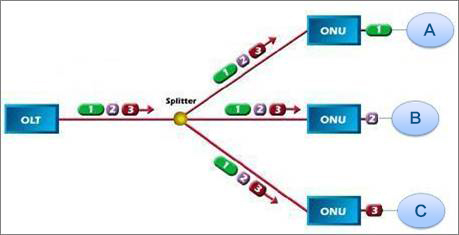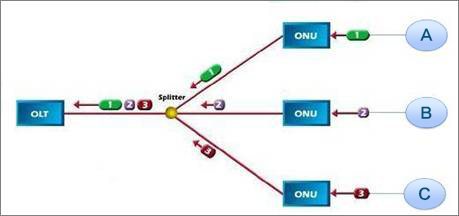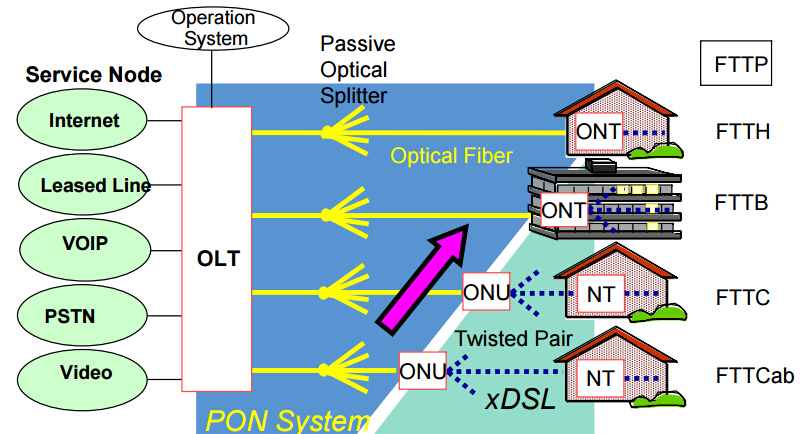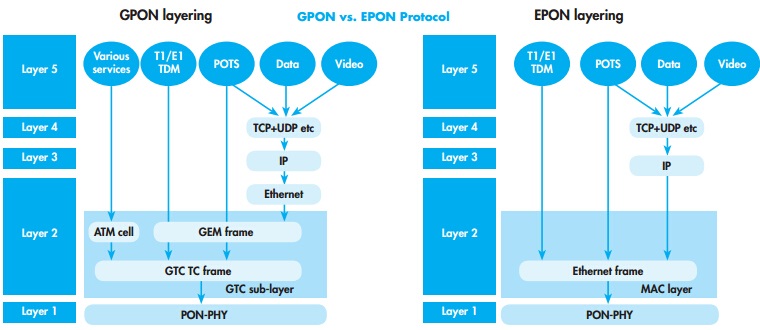In recent years, the telecommunications backbone has experienced huge growth. The tremendous growth of Internet traffic has far surpassed the network capacity. The “last mile” still remains the bottle neck between high-capacity local area networks and the backbone network. So a new technology for optical access network, which is simple, scalable but not expensive, is needed. And that is Ethernet passive optical network (EPON).
EPON, unlike other PON technologies which are based on the ATM standard, is based on the Ethernet standard. This lets you utilise the economies-of-scale of Ethernet, and provides simple, easy-to-manage connectivity to Ethernet-based, IP equipment, both at the customer premises and at the central office. As with other Gigabit Ethernet media, it is well-suited to carry packetized traffic, which is dominant at the access layer, as well as time-sensitive voice and video traffic.
An EPON network includes two parts: an optical line terminal (OLT) and an optical network unit (ONU).
The OLT resides in the central office (CO). This could typically be an Ethernet switch or Media Converter platform. OLT is mainly designed for controlling the information float across the optical distribution network (ODN). OLT has two float directions: upstream (getting an distributing different type of data and voice traffic from users) and downstream (getting data, voice and video traffic from metro network or from a long-haul network and sending it to all ONU modules on the ODN.
The ONU resides at or near the customer premise, in a building, or on the curb outside. It uses optical fibre for connecting to the PON on the one side, while interfacing with customers on the other side.
In an EPON, the process of transmitting data downstream from the OLT to multiple ONU is fundamentally different from transmitting data upstream from multiple ONUs to the OLT.
In the downstream direction (from network to user), Ethernet frames transmitted by OLT pass through a 1:N (N represents the number of subscribers each fibre can serve) passive splitter and reach each ONU. Splitting ratios are usually between 4 and 64. At the splitter, the traffic is divided into separate signals, each carrying all of the ONU–specific packets. When the data reaches the ONU, it accepts the packets that are intended for it and discards the packets that are intended for other ONUs.

In the upstream direction (from user to network ), due to the directional properties of a passive combiner (optical splitter), data frames from any ONU will only reach the OLT, not other ONUs. Frames in EPON from different ONUs transmitted simultaneously may collide. Thus, ONUs need to share the trunk fibre channel capacity and resources.

First, EPON uses a point-to-multipoint topology instead of point–to-point in the outside plant. Thus it saves much of the cost of running fibre from every customer to the CO, installing active electronics at both ends of each fibre and managing all of the fibre connections at the CO. And EPON also eliminates active electronic components, such as regenerators and amplifiers, and replaces them with passive optical couplers that are less-expensive, simpler, and longer lived than active ones. As to the cost of expensive electronic components and lasers in the OLT, it will be shared over many subscribers not paid by each subscriber.
Second, EPON offers high bandwidth to subscriber. The traffic rates of 1Gbps in downstream and return traffic of 800 Mbps have been achieved already. Compared with point–to-point technology, EPON is specially made to address the unique demands of the access work. So more bandwidth can be got by each subscriber.
At last, the main advantage of EPON is that it can eliminate complex and expensive asynchronous transfer mode (ATM) and SONET elements and simplify the networks dramatically. Traditional telecom networks use a complex and multilayered architecture. While this architecture requires a router network to carry IP traffic, ATM switches to create virtual circuits, add/drop multiplexers (ADM) and digital cross-connects to manage SONET rings, and point-to-point DWDM optical links.
EPON is suitable for Fibre-to-the-Home/Building/Business applications, including voice, data and video services. EPON is a shared network but with much higher bandwidth. It’s a highly attractive access solution for service providers to extend fibre into the last mile because of low cost and good performance, resulting from their nature as passive networks, point-to-multipoint architecture, and native Ethernet protocol.


